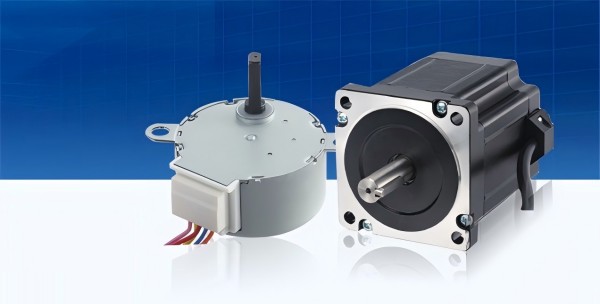In applications like 3D printers, CNC machines, robotics, and industrial automation that demand precise motion control, stepper motors are crucial. Making the choice between closed-loop and open-loop control systems is crucial.
This article examines their differences with an emphasis on benefits, performance, and suitability.

Open-loop Control System
Without feedback, an open-loop stepper motor control system functions. In this system, the motor receives electrical pulses from a controller, commanding it to move by a specific number of steps. The controller sends these pulses at predefined intervals, but there is no monitoring of the motor’s actual performance.
Open-loop control is often preferred for simpler applications, where the accuracy requirements are not stringent, and the motor operates under predictable, constant conditions.
Advantages of Open-loop Systems:
- Simplicity and Ease of Use: Open-loop systems are straightforward, with fewer components involved. They are simpler to program and set up.
- Lower Cost: Since there are no feedback components (such as encoders or sensors), open-loop systems are more affordable to implement.
- Low Maintenance: With fewer components to monitor and maintain, open-loop systems are relatively simple to maintain over time.
Disadvantages of Open-loop Systems:
- Lack of Feedback: Open-loop systems do not monitor the motor’s position, so errors such as missed steps or overshooting can occur.
- Reduced Precision: Because there is no feedback mechanism to correct deviations, open-loop systems have limited accuracy, especially in high-load or high-speed operations.
- Risk of Overheating or Stalling: If the motor is overloaded, it may stall without any corrective action, leading to performance issues such as overheating or failure.
Closed-loop Control System
In a closed-loop system, feedback is continuously provided to the motor controller. This feedback, typically obtained through sensors (such as encoders), provides real-time information about the motor’s position, speed, or current. In order to guarantee that the motor runs within the intended parameters, the controller uses this data to modify its control signals.
Applications needing great accuracy, dependability, and performance under a range of load circumstances must use closed-loop systems.
Advantages of Closed-loop Systems:
- Enhanced Accuracy and Precision: The motor can correct any deviations in real-time, resulting in highly accurate and precise operation.
- Improved Efficiency: Closed-loop systems adjust power usage based on feedback, helping to reduce energy consumption and prevent overheating.
- Better Load Handling: The ability to adjust in real-time allows closed-loop systems to maintain torque consistency, even under varying loads.
- Faster Response Times: With continuous monitoring, the system can react quickly to external changes, improving overall performance.
Disadvantages of Closed-loop Systems:
- Increased Complexity: The need for sensors and feedback components makes closed-loop systems more complex to design and configure.
- Higher Cost: Additional components, such as encoders and controllers, increase the initial cost and maintenance overhead.
- More Maintenance: Sensors and feedback components require periodic maintenance and calibration to ensure optimal performance.
Performance Comparison: Open-loop vs. Closed-loop Control Systems
To provide a clearer picture of how open-loop and closed-loop systems perform under different conditions, we’ve compiled a detailed comparison table:
| Feature | Open-loop Control System | Closed-loop Control System |
| Complexity | Simple, fewer components | More complex, requires feedback components |
| Cost | Lower initial cost | Higher cost due to additional sensors and controllers |
| Precision | Limited, no error correction | High precision with real-time corrections |
| Efficiency | Fixed power input, less efficient | Dynamic power adjustment, more energy-efficient |
| Torque Control | Less consistent, may stall or skip | Consistent torque, adapts to load variations |
| Applications | Basic or low-cost applications | High-precision, industrial automation, robotics |
| Maintenance | Low | More components mean more upkeep. |
Choosing the Right System: Factors to Consider
Selecting between an open-loop and closed-loop stepper motor system requires careful consideration of a number of factors:
- Application Requirements: A closed-loop system is best suited for applications requiring great precision, such as industrial automation, robotics, or CNC machines. However, if your application is less demanding, such as in basic fans or pumps, an open-loop system may suffice.
- Budget Constraints: Open-loop systems are more cost-effective, making them suitable for applications with a tight budget or where performance demands are not critical. On the other hand, closed-loop systems are a better choice for high-precision tasks but come at a higher cost.
- Environmental Factors: In applications where the motor is subject to variable loads or external disturbances, a closed-loop system is better equipped to handle these changes. Open-loop systems may struggle under such conditions, leading to reduced performance.
- Energy Efficiency: Closed-loop systems might be more effective if energy consumption is a significant problem. They optimize energy use and reduce waste by modifying power usage in response to real-time inputs.
Open-Loop And Closed-Loop System Applications
Open-loop Systems:
- 3D Printers: Entry-level models where high precision is not as critical.
- Domestic appliances: Fans, washing machines, and other gadgets that don’t need to be positioned precisely.
- Automation on a small scale: conveyors or other systems with steady, predictable load conditions.
Closed-loop Systems:
- CNC Machines: Where precise movement and high accuracy are required.
- Robotics: Robots performing complex tasks, such as picking and placing, require accurate feedback to ensure smooth operation.
- Industrial Automation: High-end machines that need to maintain performance under varying loads.
Conclusion: Which System Is Right for You?
A closed-loop or open-loop stepper motor control system is chosen based on the particular requirements of your application. Open-loop systems are cost-effective and straightforward but come with limitations in accuracy, efficiency, and handling varying loads. Closed-loop systems are the preferred choice for high-precision applications because they provide better performance, precision, and load handling despite being more complicated and costly.
By carefully assessing your application’s requirements, budget, and desired performance, you can make an informed decision to optimize both cost and performance.

